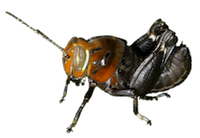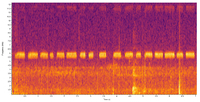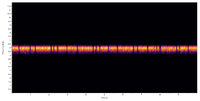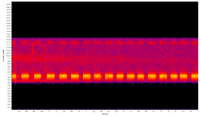Family (Alpha): ACRIDIDAE GRYLLACRIDIDAE GRYLLIDAE GRYLLOTALPIDAE RHAPHIDOPHORIDAE ROMALEIDAE TETRIGIDAE TETTIGONIIDAE TRIDACTYLIDAE
View Gryllidae Members:
Acheta domesticus Anurogryllus arboreus Gryllus unidentified species Gryllus firmus Gryllus fultoni Gryllus pennsylvanicus Gryllus pennsylvanicus/veletis Gryllus pennsylvanicus-veletis Gryllus rubens Gryllus veletis Miogryllus verticalis Velarifictorus micado Hapithus agitator Orocharis unidentified species Orocharis luteolira Orocharis saltator Cycloptilum unidentified species Cycloptilum bidens Cycloptilum pigrum Cycloptilum slossoni Cycloptilum tardum Cycloptilum trigonipalpum Cycloptilum velox Myrmecophilus pergandei Allonemobius allardi Allonemobius fultoni Allonemobius griseus griseus Allonemobius griseus funeralis Allonemobius maculatus Allonemobius socius Allonemobius sparsalsus Allonemobius tinnulus Allonemobius walkeri Allonemobius unidentified species Eunemobius carolinus Eunemobius confusus Eunemobius melodius Eunemobius unidentified species Neonemobius cubensis Neonemobius palustris Neonemobius variegatus Pictonemobius ambitiosus complex Pictonemobius ambitiosus Pictonemobius hubbelli Nemobiinae unidentified species Oecanthus unidentified species Oecanthus celerinictus Oecanthus exclamationis Oecanthus fultoni Oecanthus latipennis Oecanthus nigricornis Oecanthus niveus Oecanthus pini Oecanthus quadripunctatus Neoxabea bipunctata Phyllopalpus pulchellus Anaxipha delicatula Anaxipha exigua Anaxipha litarena Anaxipha rosamacula Anaxipha thomasi Anaxipha tinnula Anaxipha tinnulacita Anaxipha tinnulenta Anaxipha vernalis Anaxipha new species near vernalis Anaxipha unidentified species Cyrtoxipha columbiana Falcicula hebardi Gryllidae unidentified species NC Records
Anaxipha rosamacula Walker & Funk, 2014 - Pink-spotted Trig
Taxonomy
Family: Gryllidae
Subfamily: TrigonidiinaeTribe: LitarenaComments: One of thirteen species in this genus that occur in North America north of Mexico (SINA, 2017); nine of which have been recorded in North Carolina. Based on analysis of mitochondrial DNA, rosamacula and litarena were placed in the Litarena Species Group by Walker and Funk (2014).Species Status: We have added this species to the North Carolina list based solely on acoustic recordings; specimens still need to be collected to confirm its presence. Walker and Funk (2014) show the range of rosamacula extending only as far north as southern South Carolina (and without any definite records from that state).
Identification
Field Guide Descriptions: Online Photographs: SINA, Google Images ,
iNaturalist , GBIF SINA 611a.htm Comments: Pink markings are evident in fresh specimens (Walker and Funk, 2014). Structural Features: From Walker and Funk (2014): the basal metatarsal segment is shorter than the combined length of the 2nd and 3rd segments; the spines of hind tibiae have a fringe of long hairs (shown in their Fig. 2D); the hind femur lacks a dark stripe on the lateral face along the sulcus (shown in Fig. 9J); the stridulatory file has 74-93 teeth. The male genitalia are diagnostic and are illustrated (Fig. 13J) and the ovipositor is 1.4-1.8 mm in length. The ratio of the length of hind femur to that of the ovipositor is 2.4-2.8.Singing Behavior: Walker and Funk (2014) describe the song of this species as consisting of trills that are briefly broken at irregular intervals. At 77 F (25 C) the intra-trill rate is ~66 p/s, with the dominant frequency at 6.3 kHz. The song of A. fultoni is similarly irregular but the breaks are longer than in rosamacula, usually >=0.2s. The pulse rate for fultoni at 25°C is much slower, ca. 42 p/s. Anaxipha litarena also has songs similar to rosamacula, but the breaks between trills occur much more regularly.
Individuals of rosamacula heard in Brunswick and Scotland Counties, NC, match this description, with the call sounding like Morse Code, consisting of dots and dashes of buzzy triils. At the site in Brunswick County, males were heard singing two different song types, one consisting of the irregularly broken trills but followed by a series of regular, shorter trills, with 28-32 trills given in a 10 second interval at about 80 F.Diagnostic Song Parameters: Recording playback at normal speed.
Download Video:
"MP4"
Distribution in North Carolina
County Map: Clicking on a county returns the records for the species in that county.
Adult Dates: Click on graph to enlarge
Habitats and Life History
Habitats: The site where Hall and Sullivan recorded this species in Brunswick County, 6/27/18, consisted of Coastal Fringe Evergreen Forest; one male heard singing about one meter off the ground in a thicket of American Olive (Osmanthus americanus). In Scotland County, this species was found at two sites close to seepages, where Blackjack Oak and Post Oak were dominant in the canopy (indicating the presence of a clay layer). Diet: Observation Methods: Most easily detected by songAbundance/Frequency: Adult Phenology:
Status in North Carolina
Natural Heritage Program Status: Natural Heritage Program Ranks: GNR SNR [S1S3]State Protection: Comments:
Image Gallery for Anaxipha rosamacula - Pink-spotted Trig Recorded by: Steve Hall, Bo Sullivan, and Jim Petranka Recorded by: Steve Hall, Bo Sullivan, and Jim Petranka Recorded by: Steve Hall, Jim Petranka, and Bo Sullivan Recorded by: Steve Hall, Jim Petranka, Bo Sullivan Recorded by: Steve Hall and Bo Sullivan Recorded by: Steve Hall and Bo Sullivan
MP3 Gallery for Anaxipha rosamacula - Pink-spotted Trig 1
Your browser does not support the audio element.
Recorded by: Steve Hall, Jim Petranka, Bo Sullivan

 »
»




